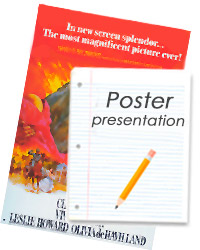Things you Should Know about Poster Presentation
 A poster presentation is a crucial assignment to present one’s ideas and thoughts in the form of text and graphics. The main gist is to convince the scholars why your project is important and show the novelty of your research.
A poster presentation is a crucial assignment to present one’s ideas and thoughts in the form of text and graphics. The main gist is to convince the scholars why your project is important and show the novelty of your research.
Today, this type of presentation is quite common among the academia, as it appeals to visual perception. As the saying goes, one picture is worth 1000 words. That is why, let us learn how to show and persuade your audience.
Firstly, a poster presentation should answer three main questions what, how, why:
- What is your project about?
It should be clear what field of studies you examine. Make sure the topic of your project is clear.
- How did you do research?
Provide some information on how you analyzed and organized your ideas.
- Why did you do it?
Convince the audience why the project is important and why it is important to you specifically.
Secondly, keep in your head the main secrets of a flawless presentation:
- Understandability
Imagine that you need to explain something to a 5-year old. Know try to explain your project. If you can do it, it means that you have done the right thing. A great presentation should be easy to understand, so keep it in mind. For instance, check how we made poster presentation examples Engineering.
- Concision
Do not use long sentences that are difficult to follow. Make sure the language is clear and concise. This is the key to persuasion.
- Visual perception
It is all about visuals: graphics, tables, pictures etc. Still, choose your design and do not try to include everything that is possible. In that case, a person will not be able to understand a thing.
See? It is not that scary anymore. If you are still a bit confused, continue reading. We have prepared some more secrets to know about.
Poster Presentation: What Not to Include?

If you have already searched for poster presentation ideas, did an in-depth analysis of your project, and learned everything about design, it is high time to see what not to include in your poster presentation.
Never put too much text and information on a poster. It is impossible to show and tell everything, whether you want it or not. Moreover, it is not needed. A person wants to grab the idea of a project and see whether they are interested in it.
Do not include the general information about your field of studies. It should be the gist of your project and the importance of it. Plus, do not make your visuals redundant. The simpler, the better. You probably do not want the audience to be dizzy, because of all the colours and figures. To see how a good project should look like search for poster presentation examples.
Now, we know what not to include in your poster presentation. We can go on to discussing what to put on a poster.
The gist of your project
Remember that a presentation should be thought-provoking, it should not tell everything.
- Hypothesis
Include the point that you are to prove. In other words, tell what your project is all about. Mention the main idea of your research.
- Data
Provide some crucial data of your investigation. Once again, include the main points only. Do not try to explain everything.
- Results
Do not forget about the evidence that proves your statement. As always, visuals like picture or tables help to convince the audience.
Your approach and methods
Show how you did the research. Mention the main methods and the peculiarity of your individual approach.
The reason you choose the project
People want to understand why this or that topic is important. For this reason, explain what influenced you to carry out the research. Provide some background information on how your project correlates with some global issues or debates among the academia.
The importance of a project
A person looking at your poster presentation should find the answer to on particular question: ‘Why am I looking at this?’ Answer this question by providing thorough explanation why your research is important in that particular field.
Quick Guide: Wording on Poster

As we have already discussed this, the text in a presentation should be easy to understand. Therefore, use simple sentences. Avoid complex sentences with too many words. Statistically, people tend to scan big blocks of a text or even skip them at all. You do not want that, do you?
To make it easier to grasp the idea of your project, structure the text. Whenever you write a paper, you organize your assignment. You should organize the wording as well. A well-organized text always appeals to the audience better, as our brain tends to like simple information. See how it is done in a poster template Word.
Even though, an eye-catching design is welcome, be careful with the language you use. Avoid jargon vocabulary or slang words. This task is an academic research, so make sure it meets all the academic standards and requirements.
How to Choose a Layout?
Let us divide a poster into 3 areas: top, center, and bottom. Depending on what information you need to include, you will choose a particular part of a poster. Here is how it works:
- Top
The top part should include the title of work and the author.
- Centre
The central part is the place where you include the main points of research: introduction, findings and conclusion.
- Bottom
The bottom left part is for methods and discussion. The bottom right part is for acknowledgment and references.
Usually, a person’s eye reads from top to bottom, from left to right. Keep this in mind when you are going to structure your poster. In addition, do not forget to examine the best poster presentation examples to see yourself everything on practice.
Do Proportions Matter?
The poster presentation format may differ, so you are not limited to some strict rules. Still, there are standards to meet and secrets to know about. Usually, you highlight the most important information of research. It is obvious. Therefore, the more significant is the block of text, the more space you leave it.
If you want to compare your ideas with already made examples, check out a poster template free download.
White Space Percentage on a Poster
When it comes to white space, the figure are the following: 10%-30% of a poster. The white space is needed for a person to distinguish among the sections. Plus, it is essential to make the text easier to read and perceive. As always, better to see once, than hear a hundred times, so examine some project poster example.
Do not Forget about Graphics
We have already discussed lots of poster presentation tips, now let us get down to the essentials. That is graphics. The whole idea of a poster is that people can see the information and understand it better. Therefore, you should dedicate your time to organizing pictures, illustration, table, photos etc. Remember that any visual item you include needs to be important. You cannot just provide random pictures to make your project eye-catching. It should be both attractive and informational.
Make sure that complex information is presented in the form of an easy-to-follow table or chart. Grab the attention of your audience and convince them in the significance of your research.
To see more try a research poster template free download, it will be much easier to understand what we are talking about.
7 Secrets No One Told You About a Poster
- We have singled out top 7 secrets to follow and make your poster presentation rock:
- 1. Use Large Font. It is a poster, so you can make the text too small. If you saw the banner with a teeny-tiny text, would you ever read it? Probably, not. Therefore, make sure that the text is readable.
- 2. The best font choice is Verdana or Helvetica, as the characters have simple forms. That is why, it is easier to read these fonts than Times New Roman, for instance.
- 3. Never mix the fonts. You do not want the poster to blur with all the different forms. It is much easier to focus on one font.
- 4. Do not be greedy for spacing. Choose either 1,5 or double spacing.
- 5. Italic, bold or coloured fonts are welcome. Use them to highlight the important points. Still, use them in moderation, so the information is easy to perceive.
- 6. Never use capitalization to make something stand out. It just makes the text more difficult to read.
- 7. To guide people through your poster use bulleted or numbered lists.
Theory is great, but make sure you check poster presentation templates as well.
How to Market Yourself?
The first impression always matters, so make sure you know how to present your poster. Prepare the information on what you want to say. Make some notes to follow and peek if needed. Get ready to questions, as some people may want to know some additional information on your research.
How to Get Ready For Presentation?
You have done the research. You have crafted a perfect poster. There is one thing left. Prepare for the presentation.
The best way to practice your presentation is to really practice it. Imagine you are at the conference, your friends, classmates or parents are your audience. Present them your poster. It should not take longer than five minutes Make sure they ask some questions. What is more, you can think what questions you may be asked. This is the great way to be prepared.
While presenting your project, remember to highlight the most important points and provide convincing details. Do not be shy to market your research.
How to Talk to the Audience?
Statistically, it takes around 3 minutes for a person to examine a poster. Do not rush to people straight away and dwell upon your research. Take some time, come and greet them. After greeting them, you may ask whether they want to hear some additional information on your project. Only after a bit of small talk, you can wonder whether they have any questions. If yes, answer them and see how the discussion goes. There is nothing better than feedback straight from the audience.
Can I Read from the Poster?
A poster is for people to see and read, not for you. You should know all the data and information presented on the poster. The best way is to tell about your research and use photos, illustrations, tables on a poster as visual aids.
Now as you are through our poster presentation guidelines, we feel you are ready. Still, if you have any questions left, do not hesitate to ask us for help.
